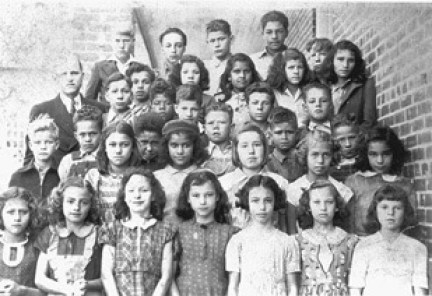“Lumbee Indians in the Jim Crow South: Adapting to Segregation”
The following is an excerpt from Malinda Maynor Lowery’s Lumbee Indians in the Jim Crow South: Race, Identity, and the Making of a Nation. With more than 50,000 enrolled members, North Carolina’s Lumbee Indians are the largest Native American tribe east of the Mississippi River. Malinda Maynor Lowery, a Lumbee herself, describes how, between Reconstruction and the 1950s, the Lumbee crafted and maintained a distinct identity in an era defined by racial segregation in the South and paternalistic policies for Indians throughout the nation. They did so against the backdrop of some of the central issues in American history, including race, class, politics, and citizenship.
Lowery’s Lumbee Indians in the Jim Crow South: Race, Identity, and the Making of a Nation was featured recently on our Native American Heritage Month reading list.
My family photographs ring with layers of belonging; we have one of the Pembroke “graded school,” or elementary school, that features my dad’s sister Faye (Figure 2). She is on the left end of the front row, and my great-uncle Theodore Maynor is the teacher (third row, left end). Aunt Faye was in the first grade, but some of those children on the top row don’t look like first graders—they’re preteens but most likely in their first year in school. Each child in this picture came from an Indian household; they had two Indian parents and lived within a few miles of Pembroke, close enough that they could walk to school. Few Indian children had access to a school bus, but the Pembroke graded school did have a sturdy brick building, evincing their modest prosperity compared to more isolated communities. I can imagine my grandmother Lucy mending the special collar she had sewn for Faye’s dress the morning this picture was taken; I can picture Faye practicing an appropriately serious expression in front of her mother’s dresser mirror—the only mirror in their five-room house, which was large for that time and place. My grandfather Wayne, a schoolteacher like his brother Theodore, was probably in the yard feeding the hogs; or maybe he was plating a few biscuits with molasses for my dad, Waltz, then only five years old. In a few years, Waltz, Faye, and their siblings would rise before dawn to pick cotton so they could go to school that day.
But this scene is just a fiction to me; my grandmother died before I was born and my grandfather died when I was three, so I don’t recall their voices or personalities or the atmosphere in their home. In fact, just trying to access 1938 is difficult. I didn’t go to a segregated school, but the faces in my class pictures looked just as varied as these do. This photo poses some questions: How did the segregation era, marked by a supposedly iron-sided wall between the races, evidence so much variety? What were the contours and boundaries of racial segregation for Native American southerners? How did their identities function, and how did the concept of race become institutionalized out of an identity based on kinship and settlement?

These are questions that historians now ask, knowing that race and color became definitive categories in American society in the twentieth century. But at that time, Indians asked another question, one that had little to do with their position in the racial hierarchy and everything to do with their identity as a People: how do we maintain our autonomy while promoting opportunity and prosperity among our people? Faced with the challenge of an emerging color line and whites’ defense of it, the answer was no less ambiguous than the social and political air they breathed.
By 1910 white supremacy dictated the separation of racial groups in urban public facilities—schools, churches, restrooms, drinking fountains, movie theaters, buses, streetcars, hospitals, and other places. In Robeson County, that separation was threefold in the county seat of Lumberton. There were different facilities for whites, blacks, and Indians. In the county courthouse, each group had its water fountains and restrooms, while the Lumberton movie theater boasted a balcony divided by wooden partitions for the Indian and black patrons. In the county’s private places and in rural areas and small towns, however, the picture is less divided and more like the one of my aunt’s school class: variegated, but with a certain logic once one looks below the surface. White supremacy was at once arbitrary and systematic.
Indians took step-by-step advantage of the post-Civil War racial environment to add another layer to their strategies for maintaining identity. Segregated schools and churches, along with the growing obsession with a hierarchy of color and ancestry, fostered a racial identity and helped Indians affirm their identity as fundamentally different from whites and blacks. However, adopting segregation to preserve distinctiveness proved to be a double-edged sword: excluding blacks and whites from their community assured Indians control over some of their own affairs, but it also conceded whites’ power to govern race relations. Indians operated within the constraints of white attitudes about the racial hierarchy and, to a certain extent, had to determine their social boundaries according to what whites were willing to accept. Even so, they employed their own values in monitoring social contact with both whites and blacks.
Malinda Maynor Lowery (Lumbee) is Cahoon Family Professor in American History at Emory College. She is the author of The Lumbee Indians: An American Struggle.



You must be logged in to post a comment.